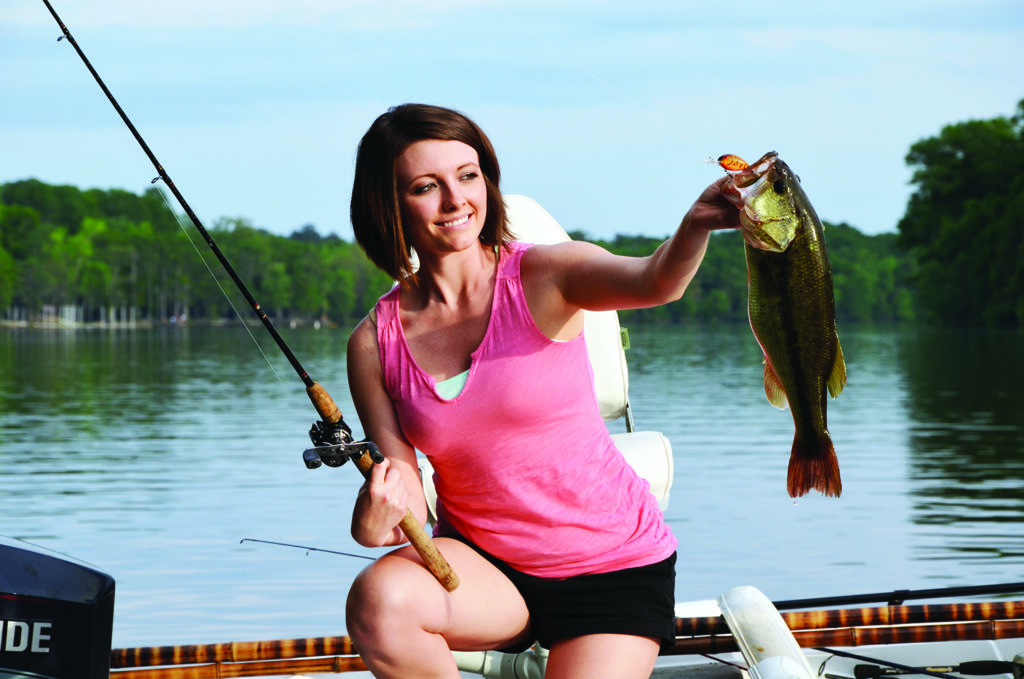Diverse crankbaits can tempt bass all year long
By John Felsher
More than a century ago, Henry Dills of Garrett, Indiana inserted a “stair-step” metal lip into the nose of a wooden plug and created a new form of fishing lure.
The lip made the bait wobble like a struggling baitfish while the wood provided buoyancy. Among the oldest and easiest baits to use, crankbaits still catch fish because they resemble what fish want to eat – smaller fish!
“Crankbaits are very versatile baits to throw all year long for largemouth, smallmouth and spotted bass,” says Gerald Swindle, a professional bass angler from Guntersville. “For colors, I like orange or red, something that looks like a crawfish, for fishing in super cold water. As water warms, I throw white or light shad colors. In dirty water, I’ll mix in some blue and chartreuse or brown and chartreuse.”
Today, some crankbaits still use metal lips, or bills, but most come with plastic in various sizes and shapes. Some lures come lipless and give off tight wobbles with slim baitfish profiles. Many crankbaits also include internal rattles that produce vibrations fish can detect from long distances.
The longer and narrower the bill, the deeper the lure dives. Baits with long, scooped bills run deep, but can easily tire an angler repeatedly cranking them back to the boat. However, they make good choices for trolling in deep water. Long, slender lures create subtle action that mimic shad. These baits typically work best during temperature extremes when bass go deeper and become more lethargic. When fishing these baits, use shad colors such as white or pearl.
“The thinner the bill, the tighter the wobble,” Swindle says. “In the winter, I like to throw small wooden crankbaits with tiny, rounded bills that produce very little action. The tight wobble is like a shad in cold water, almost like a lipless crankbait.”
Fish become more active as water warms in the spring. As the season progresses, bass begin to prey more heavily upon bluegills and other bream species. Short, rounded baits mimic bream and create erratic action. When bass prey upon bluegills, use colors like chartreuse and blue or chartreuse with some orange in it.

Becky Smith lands a bass that hit a crankbait in the Mobile-Tensaw Delta near Mobile, Ala. Crankbaits work best when bass key on shad or other baitfish. Photo by John N. Felsher
“When bass target bream, I throw a crankbait that looks like a bream,” Swindle says. “Whenever I’m fishing hot water, I want a big, wide wobble. If I’m throwing in shallow cover that I can see, I always go with a fat, square-lipped crankbait. I usually throw a square-bill crankbait from late spring through early fall.”
Crankbaits with squared lips give off excellent vibrations so they work great in murky water and at night. They don’t dive very deep, making them superb choices for fishing around thick cover such as fallen trees.
“A square-billed crankbait is one of my go-to baits,” says Kevin VanDam, a four-time Bassmaster Classic champion. “They have become a mainstay for catching bass in shallow zones. With angled bills, they deflect off cover well. People can fish them in laydowns, brush, rocks, gravel beds, grass and other cover. Many people think a square-bill is only a warm-water bait, but I’ll use one all year long whenever the fish are up shallow.”
Most anglers simply throw crankbaits into likely spots and reel steadily toward the boat, letting the lures provide the action. That catches fish, but anglers who vary their retrieves commonly catch more and bigger bass. Vary the retrieval speed and depth to see what fish want that day.
“Very seldom do I just steadily retrieve a crankbait,” Swindle says. “I don’t jerk it either unless I’m trying to clear the grass. The warmer the water, the more aggressive I work a bait. The stop-and-go retrieve is probably the most effective way to retrieve a crankbait. I make a few turns on the reel and stop for a few moments. Then, I start winding again.”
Many anglers deliberately bump crankbaits into logs, rocks, pilings, stumps or other cover. When the bait thumps against an object, pause the retrieve to simulate a fish that just stunned itself. More rounded, buoyant baits float over objects. When the bait clears the object, resume the retrieve. If the lip hits bottom, also pause to let the lure float upward a few feet. Lips digging into dirt simulate crawfish scurrying on the bottom.
Few bass would ignore an opportunity to snatch a struggling shad, bream, crawfish or other prey. Anglers just need to experiment with different styles and colors when they get cranking!
John N. Felsher is a professional freelance writer who lives in Semmes, Ala. He also hosts an outdoors tips show for WAVH FM Talk 106.5 radio station in Mobile, Ala. Contact him at j.felsher@hotmail.com or through Facebook.





